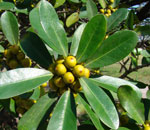Ficus natalensis
Natal Fig;
Natalvy; umDende or umThombe (X and Z); asiHlamfani (Thonga)
Article by Geoff Nichols
We humans give figs
a bad name by planting them or
allowing them to grow too close to our dwellings and structures, like
swimming pools and sewer lines. Leave at least 5 metres of space
between your house and
a fig tree. The roots of figs travel large distances to get to water
just
look at the chimney specimen, it is at least 25 – 30 metres high.
Along our
KwaZulu-Natal coast this tree has often been used to
demarcate farm boundaries. I’m quite sure the farmers just lopped
branches of big
trees and stuck them in along the boundary line as giant cuttings or
truncheons. Now 50 –80 years later these trees are local landmarks.
|

Click
Here
|
To grow Natal Figs is an
easy process, large cuttings work well but ensure you get the right
original shape by allowing for an open arching shape. Do not just stick
in a pole this will result in a “witches broom” top of many little
branches that as they mature become quite weak and are not able to
support
the weight of the branch because the coppice shoots are not set in the
woody
tissue of the trunk.
Seed in my opinion is the best method of propagating this species.
Collect the figs from under the tree squish them between your fingers
and sow this pulp on a seed tray filled with a sandy well drain
seedling mixture. Once the seeds germinate in about 10-14 days prick
out the seedlings into individual containers. These plants must be in
full sun to allow for maximum growth
and vigour. The sunlight also helps to reduce soil pathogens like
damping
off fungus.
From a wildlife point of view these trees are heaven on earth as they
get older and begin to set figs. The figs are eaten by everything. The
beautiful fig tree blue butterfly caterpillars eat even the leaves. The
soft wood
of dead branches make wonderful nesting logs for birds like Barbets and
Woodpeckers.
As a Bonsai this species Natal Figs are virtually unsurpassed in the
shapes that can be created from the plant.
